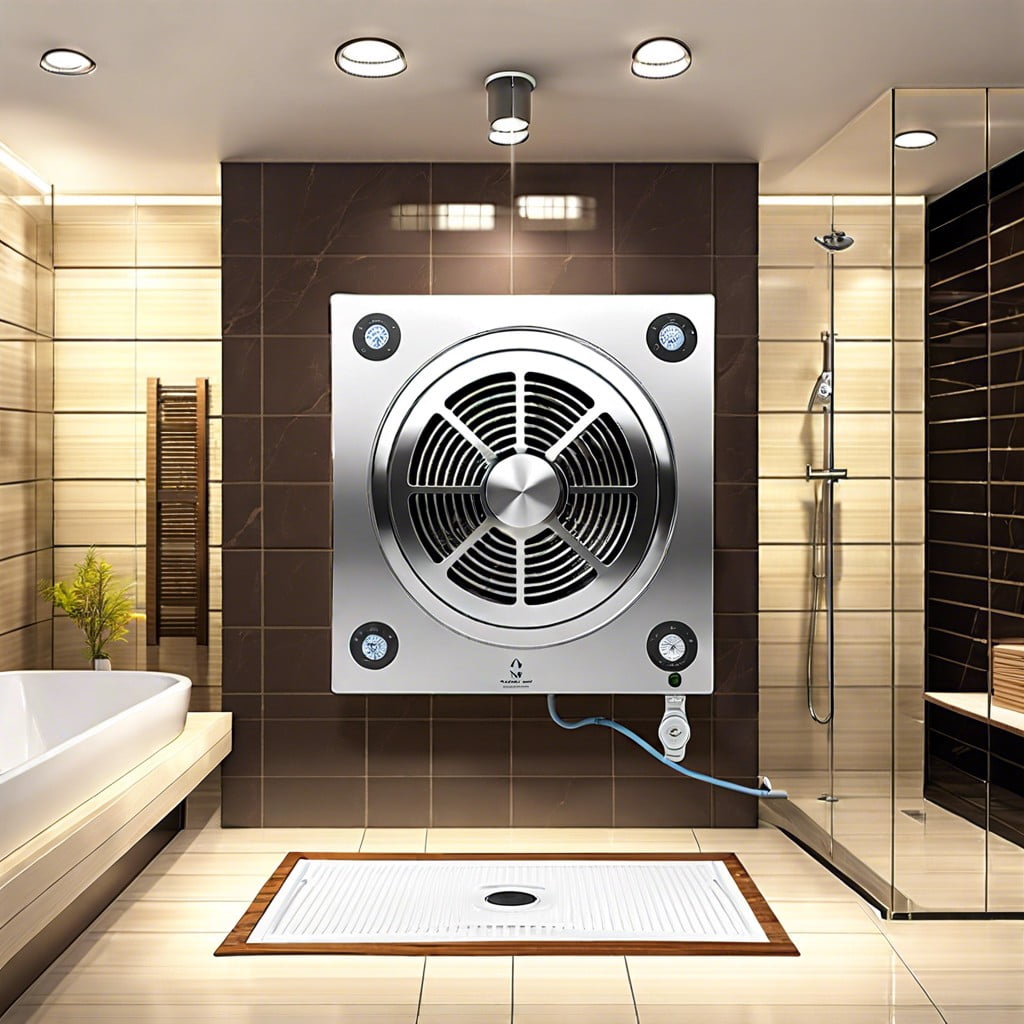Last updated on
Discover the steps to properly vent your bathroom fan to the outdoors, ensuring efficient moisture removal and preventing mold growth.
Key takeaways:
- Assess ventilation needs based on bathroom size and humidity levels.
- Familiarize yourself with local building codes and regulations.
- Follow a step-by-step guide for proper installation of the fan and ductwork.
- Ensure proper ductwork installation and seal connections tightly.
- Maintain the fan regularly for maximum efficiency and energy savings.
Assessing the Ventilation Requirements
Before embarking on the installation journey, gauging the specific ventilation needs of your bathroom is crucial. This step ensures that the fan you install can handle the space’s volume effectively.
To get it right, you’ll need to calculate the bathroom’s cubic footage (length x width x height) and match it with a fan that offers appropriate cubic feet per minute (CFM) airflow capacity.
For rooms with higher ceilings or larger square footage, consider opting for higher CFM models to maintain proper air exchange.
It’s also wise to factor in the additional workload for fans venting multiple fixtures or those installed in bathrooms with high humidity levels.
Remember, overestimating slightly is better than underserving your bathroom’s ventilation needs.
Understanding Local Building Codes and Regulations
Familiarity with local building codes is paramount before any installation commences. These regulations ensure that venting systems meet safety standards and function properly. Key points to consider include:
- Exhaust Point: Codes often dictate where the exhaust must terminate, typically leading the air outside to avoid moisture buildup within the home.
- Duct Material: Certain materials may be required for ductwork; for example, some codes prohibit the use of flexible ducting due to its susceptibility to sagging and collecting moisture.
- Moisture Control: Provisions may exist that specify how to handle moisture in the duct to prevent condensation problems.
- Ventilation Rates: There are minimum standards for air movement, measured in cubic feet per minute (CFM), ensuring the fan adequately removes humidity and odors.
- Backdraft Prevention: The use of backdraft dampers, which prevent outside air from flowing backward through the fan, might be mandatory.
- Noise Levels: Some codes include maximum noise levels for bathroom fans, ensuring a quiet and serene bathroom environment.
Adhering to these points minimizes future complications and ensures a compliant bathroom ventilation system that stands the test of inspections and time. Always consult with or hire a professional if uncertainty exists regarding these regulations.
Step-by-Step Guide for Venting a Bathroom Fan
Firstly, determine where the fan will exhaust. Choosing a short, straight path to the outside will minimize both the fan’s workload and potential for moisture buildup in ducts. Ideal exit points include the roof, soffit, or gable wall. Each comes with its pros and cons; roof venting, while direct, can lead to leaks if not properly sealed, while soffit venting must avoid drawing moist air into the attic.
Before cutting any holes, take precise measurements and mark your exit point from inside the attic, ensuring it is free from obstructions such as wires, pipes, or structural components. Then, proceed to the rooftop or exterior wall and use a hole saw to create an opening that matches the size of your vent cap or ducting.
Once the path for the ducting is clear, attach the ductwork to your fan’s housing using clamps or metal foil tape, not duct tape, as heat and moisture can cause it to fail. The metal foil tape ensures a secure, airtight seal, preventing condensation and the subsequent growth of mold.
Extend the duct to your previously made exit point, making sure its run is as straight and short as possible. Use straps to support the duct every few feet to prevent sagging, which could trap moisture or impede airflow. At the exit, fit a vent cap to the duct and secure it to the house’s exterior. This cap keeps pests and rain out and should include a flap that opens when the fan is on.
Finally, turn the power back on and test your fan. A successful vent installation will mean quiet operation, efficient moisture removal, and an absence of backdrafts, indicating proper external venting. Regular maintenance from this point forward ensures the fan remains effective and safe.
Ensuring Proper Ductwork Installation and Sealing Connections
Avoiding leaks and ensuring efficiency hinge on meticulous ductwork installation. Start with insulated ducts to prevent condensation and mold growth in attics or crawl spaces; use rigid metal or flexible metalized ducts but steer clear of easily-crushable plastics.
Next, shorten the duct route to the exterior: less distance equals reduced air resistance and better fan performance. Straight runs are ideal, but if bends are necessary, maintain broad curves to minimize airflow disruption.
When attaching the duct to the fan and vent cap, tight seals are paramount. Employ metal foil tape or mastic sealant, not duct tape—it fails under extreme temperatures. Ensure all joints are secure; loose connections spell trouble for air flow and can introduce unwanted moisture.
Additionally, an airtight seal between the fan housing and the ceiling prevents moist air sneaking into the structure. Apply caulk or foam gasket as prescribed by the manufacturer.
Remember, precision now prevents performance woes and pricey repairs later.
Maintenance and Energy Efficiency Tips for Bathroom Fans
Regular maintenance is key in maximizing the efficiency and lifespan of your bathroom exhaust fan. Dust accumulates on fan blades and in ductwork over time, leading to decreased performance and potential air quality issues.
Here are some actionable tips:
- Clean your fan grills and blades at least twice a year to prevent dust build-up and maintain airflow.
- Check and tighten any loose screws or fittings annually to prevent vibration and noise, which might indicate an inefficiently running fan.
- Replace the fan’s filter, if applicable, according to the manufacturer’s schedule to ensure clean air circulation.
- Opt for insulated ducting to minimize temperature fluctuations that could increase energy usage.
- Consider installing a timer switch or a humidity sensor to ensure the fan runs only as long as necessary, reducing wasted energy.
- If your current fan is loud or seems to struggle, it may be time to upgrade to a newer, more energy-efficient model with a higher CFM (cubic feet per minute) rating appropriate for your bathroom’s size.
- For true efficiency, ensure that the exhaust fan vents to the outside, not just into the attic or another space in your home, to prevent moisture problems elsewhere in the structure.
Continue reading:
Recap


